Air Pistols of a certain type
What exactly is a “small gun?” The answer to that not only depends upon whom you are asking, but in what century! Small guns have been around for hundreds of years. Back in the 1840s the answer was Henry Deringer’s Philadelphia-built single shot percussion lock pistol, or a similarly designed gun (Deringer was blatantly copied by others who got around it by spelling his name with a double “r” as Derringer and using it to describe their gun as a type of pistol). By the 1860s, Smith & Wesson had redefined small pistol with its 5-shot, metallic cartridge loading No. 1 revolver chambered for .22 short rimfire and No. 1-1/2 for .32 rimfire. But a small gun could also be a.32 caliber Colt Root sidehammer cap and ball pistol, or Colt’s Model 1848 and 1849 cap and ball pistols. What they all shared in common was size; these were really small guns, even by today’s standards.

By the 1880s, when medium to large caliber cartridge revolvers were the dominant sidearm, a small gun was bigger than before, if it was a revolver, and by the turn of the century, it was smaller, certainly flatter, if it was one of those newfangled, magazine-fed small caliber semiautomatic pistols designed for Colt by John M. Browning. Fabrique Nationale (FN) had similar guns to Colt, also designed by Browning, and built in Belgium for the European market.
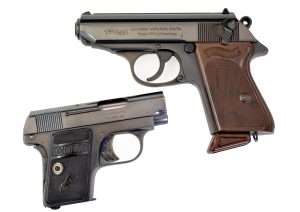
By simple definition, a “small gun” in the 18th, 19th, and 20th centuries was one that could be easily carried in a pocket, purse, or otherwise easily concealed on the person, whether it was a single-shot cap-and-ball pistol, a double barrel Remington Derringer, a 5-shot small caliber revolver, or magazine fed semi-auto. Today, there are still equally small revolvers in .22 LR and .22 WMR, Derringers in calibers up to .45 Colt (and .410 gauge), and semi autos in .25 and .32 caliber ACP, (as well as surviving originals like the .25 caliber Colt Model 1908 Vest Pocket hammerless and FN Baby Browning), so these small pistols have never gone away, but they have been overshadowed in recent years by Micro Compact semi-autos in larger calibers.
Today, a small gun can be chambered in almost caliber imaginable from .22 LR up to .44 Magnum and even some rifle caliber cartridges. In .177 caliber, however, the number of small gun choices are few for CO2-powered pistols, each unique in their design and history, with some original designs dating back before WWII, and others dating no further back than the last year. So, let’s review several of the smallest blowback action CO2 pistols you can own, the first of which remains the oldest, not only as an original design but also as a CO2 pistol.
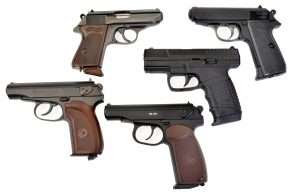
The Walther PPK/S from Umarex is based on the pre-WWII PPK and post-WWII (1968) Walther PPK/S designs and was the first blowback action CO2 pistol made by Umarex. It was and still is a fairly anemic little gun that shoots under 300 fps and is best suited for 15 foot distances for any degree of consistent accuracy. It isn’t an expensive CO2 model, which is good because it uses a stick magazine and has a fairly flat black finish, which is not what a PPK or PPK/S looks like, as you can see from the pictures of the .380 ACP model. The rest of the earlier CO2 pistols that fall into this category are all vastly superior to the PPK/S but they cost a little more.

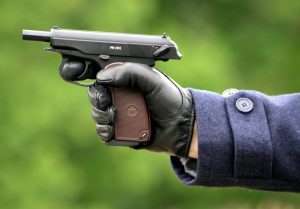
There two really nice ones, the Gletcher PM 1951, which is hard to find now, and based on the Soviet Makarov. This air pistol has a proper self-contained CO2 BB magazine, a locking slide, correct-style thumb safety, and a really smooth SA trigger pull. It has also proven itself to be pretty accurate at 21 feet and it will consistently break 300 to 320 fps, which is right up to par with most blowback action models, only this one is in the Subcompact pistol category. With an average velocity for the test gun of 329 fps, trigger pull was an exceptional 4 pounds, 14 ounces average with a short take up and almost instantaneous reset. It is one of the best air pistol triggers I have tested, which adds to the PM 1951’s surprising accuracy. The safety clicks on and off with authority and the slide release feels exactly like one on a cartridge-firing handgun, not a copy of one. Even though the original-style sights are not the easiest to acquire, the gun is steady in the hand and the 3-1/2 inch smoothbore barrel delivers better accuracy than expected. At a test distance of 21 feet, my best 10 shot group, out of 16 shots, a full magazine, fired offhand using a two-handed hold, covered 1.125 inches. I had a trio of flyers that hit left but most were at POA in the 10 and X.

The PM, Pistolet Makarova, was originally issued to Soviet officers during what we look back upon today as the “Cold War Era” when the U.S. and Russia began a chilly and dangerous game, the stuff of which spy novels, television series and movies have been based upon for decades. Until President Ronald Regan uttered those historic words, “Mr. Gorbachev tear down this wall” on June 12, 1987, the cat and mouse game of Cold War detente that America and Russia had played helped make guns like the Makarov legendary. It also became a popular handgun in the U.S. and as a CO2 model Gletcher steered clear of using plastics for the airgun’s construction. By using all metal components, this CO2 copy of the famous Soviet pistol provides greater durability, more accurate styling, proper weight, and method of operation. It’s also not too difficult to see that the Makarov is “inspired” by Germany’s Walther PP and PPK models.

The next, shall we say, vintage entry, is the exact same model only as produced by Umarex in its Legends series as the Makarov Ultra. Not all of the good things I said about the Gletcher PM 1951 apply to the Ultra. It has a self-contained CO2 BB magazine but with an external seating screw. The Umarex has a more accurate slide release, serrated hammer shape and more accurate trigger shape; it also has a proper length grip frame, while the Gletcher is a bit too long, necessary to contain an integral seating screw. The Ultra’s external key makes the grips the right depth, but looks, well, it doesn’t look good, what can I say? The trigger pull is much heavier as well, but the gun has some advantages like an average velocity as tested of 358 fps. It’s about as accurate as the Gletcher, so no real advantage there. Overall, in my book, the Ultra is not quite as good of a gun in those respects and as for size it still falls into the small gun category.
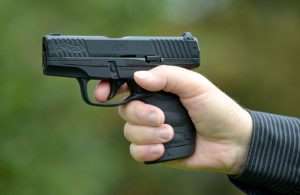
The next gun is just plain confounding, the Umarex Walther PPS. This has been the best darn little CO2 pistol for several years, It is no smaller than the post WWII Russian guns, but way narrower, a slide width of 0.75 inches, total width of 1.0 inches, a slide that locks back, excellent white dot sights, a wickedly light SA trigger and accuracy that matches its centerfire counterpart at 21 feet. What’s not to like about this little blowback action pistol? It has a stick magazine and loads CO2 in the grip frame by removing the backstrap. Still, I really like this very affordable airgun for practice with concealment holsters. My test of the PPS (and there is a newer PPS M2 CO2 model, but I like the older style gun better), clocked an average velocity of 365 fps with Umarex steel BBs and I shot a best 5-round group from 21 feet measuring 0.56 inches with two shots in one elongated hole at 3 o’clock across the bullseye and 10.
It’s hard not to give this gun a pass despite its stick mag. And until this year it remained my favorite small gun in CO2, and then Sig Sauer did this. They made a seriously small gun in 9mm and a matching one in .177 caliber, the P365.
How the P365 Changes Small Gun Thinking
Sig Sauer wanted the P365 to be as authentic in handling and size as possible for a blowback action CO2 pistol, and in order for the airgun to achieve that goal they had to make it smaller than any other blowback action model and incorporate a self-contained CO2 BB magazine. To achieve a compact CO2 system to fit within the framework of the 9mm pistol; the air pistol cannot be field stripped like the centerfire model, but it has the same measurements as its 9mm counterpart but with a groundbreaking CO2 BB magazine that takes up the same amount of space as the Micro Compact’s 9mm.

One of the more interesting aspects of that, aside from being the smallest self-contained 12 gr. CO2 BB magazine ever devised for a blowback action air pistol, is that it loads very similarly to the 9mm. The Sig has what I would call a “zero aggravation” loading system for the 12 rounds of .177 caliber steel BBs. It has a very easily set locking follower but no loading port above it. Instead of having to pour BBs into the channel, you use your index finger to press the BB stop down (as the breech end of the barrel does when the magazine is inserted into the gun), and then load each BB into the channel one at a time. When all 12 rounds are loaded, you release the locking follower and the magazine is ready to load into the pistol.
The trigger pull on the test gun was 5 pounds, 6 ounces, with only 0.3125 inches of total take up to a crisp break. The trigger moves back 0.25 inches with almost zero resistance, and then there is a firm 0.125 inches until the trigger pull breaks the shot. There is no creeping with the CO2 model’s trigger, just a steady increase in resistance (stacking) common with a double action (or DAO) trigger. The pistol exhibits no over travel and the trigger has a quick reset. This all compares favorably with the centerfire pistol’s 6 pound average trigger pull.

This little air pistol is loud when its goes off and BBs slap into the target with more force than the velocity would suggest, a velocity that is just under 300 fps, right back where we started years ago with the Umarex Walther PPK/S, but with a much, much more accurate pistol, and a slide that comes back with the force of a small .22 LR handgun. You know this gun is working hard to deliver as much tactile feedback as any CO2 pistol, regardless of velocity. And despite its sub 300 fps averages the P365 is accurate at 21 feet, delivering its 12 round charge of .177 caliber steel BBs into 1.75 inches with a best 5-shot group measuring 0.68 inches.
Small Conclusions
We have classic small WWII and post WWII pistols, and modern small pistols, and in terms of CO2 powered handguns, I don’t think you can surpass the Sig Sauer P365 when you compare it to the other airguns in its class. Yes, I still like my old Umarex Walther PPS a lot, but I think it has to move over and make room for a Sig!
A word about safety
Blowback action airguns provide the look, feel and operation of their cartridge-firing counterparts and this is one reason why they have become so popular. Airguns in general all look like guns, blowback action models more so, and it is important to remember that the vast majority of people can’t tell an airgun from a cartridge gun. Never brandish an airgun in public. Always, and I can never stress this enough, always treat an airgun as you would a cartridge gun. The same manual of operation and safety should always apply.


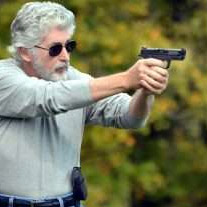
I have the gun on order but my Fobus 365 Holster arrived today and there is no way my PPS will get into it .
It is tiny by comparison with the PPS.